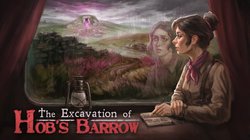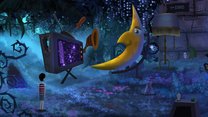The Excavation of Hob's Barrow review – Richly atmospheric mystery a slow climb to a great finish

- 2 Comments
If as a child you ever agonizingly picked your way through a bland dinner just so you could get dessert, then you’ll have a good idea what it’s like to play The Excavation of Hob’s Barrow. The good news is that with this latest point-and-click pixel art adventure from Cloak & Dagger Games (and publisher Wadjet Eye), there’s a three-layer chocolate mousse waiting for you at the end.
Sometime near the turn of the 20th century, antiquarian Thomasina Bateman is writing a book about the barrows of England and decides to visit the small village of Bewlay, where Hob’s Barrow awaits. She is there on the invitation of a local denizen who promised to assist her with the excavation. However, when Thomasina arrives he is nowhere to be found, and nearly every person in town sidesteps her questions and hinders her investigation. Determined to finish what she came for, Thomasina must now find friends where she can and piece together the mystery shrouding the ancient burial mound.
The first considerable misstep in the game design is that the player is not trusted to employ any deduction. Thomasina literally narrates everything. She will tell you where she came from and where she’s going. She will tell you every thought that enters her mind. She will explain the tenor of every conversation. She will make sure you know every feeling she is feeling. And she will announce how to proceed with most every puzzle. While the atmosphere is supposed to be intense and foreboding, the moment is never allowed to breathe. The game is more than a mere walking simulator, but at times I felt I was on the same rails Thomasina rode into town.

The puzzles don’t improve things either. One early obstacle has no intuitive solution, as it can only be solved by arbitrarily finding the necessary item whilst solving a different puzzle. Other tasks require no intuition at all; indeed, one is solved just by talking to a particular character and exhausting the conversation tree until they decide to solve it for you. The nadir is on the second day, when Thomasina’s primary objective is to round up some local workers to help her excavate the barrow. The day ends with her having done so, but on the way she engages in the mother of all fetch quests, finding random item after random item to get other people to agree to help her with only the loosest of connections to the overall goal. When she delivers the final item, she says out loud, “You have no idea what I went through.” We do, Thomasina. We do.
In between all the busywork, the game tries to build up the suspense for excavation day. There is an early, effectively creepy scene that sees Thomasina brave a dark forest at night, but it results only in a jump scare that is completely unconnected to the plot. Thomasina also experiences disconcerting (and interactive) flashbacks to her childhood so we watch her science-driven father groom her for archaeology. However, nothing that occurs in these flashbacks is surprising, as Thomasina has already alluded to the same events already. There is one quite unsettling discovery near the end of the second day that sets up horrors we learn later on; unfortunately, it’s quickly interrupted to finish the banal fetch quest.
But more than all that, the suspense in this horror adventure is muted because almost none of the characters act like they’re in a horror adventure. Thomasina, beholden to science, coldly dismisses every odd or creepy thing with reason. The townsfolk insist they’ve never heard of the barrow or are otherwise not interested in the excavation. Even the guy who invited her—once Thomasina finally finds him—is fairly nonchalant about the whole thing. Only one person warns Thomasina about the horrors awaiting her, and even he knows so little about the barrow that Thomasina rejects him out of hand. As a result, she wasn’t even the least bit nervous, and neither was I.

Thankfully, the characters are enjoyable enough to go along for the ride. Thomasina (voiced beautifully by Samantha Baért) is intellectually feisty and emotionally earnest. She even dares wear trousers! While the other characters are not nearly as rounded out, they have distinct personalities and generally rise above small-town folksy stereotypes. The rest of the voice acting is generally good as well, though it is quite obvious that many minor characters are performed by the same person without much variation. The game’s other production values are solid if not groundbreaking. The iconless mouse interface is intuitive, with just two buttons for examining and interacting; use of inventory is a breeze. The music (which includes one original song!) is always unobtrusive and appropriate to the mood.
The scenic backdrop does a nice job of transplanting you into rural Victorian-era England, with stone fences, thatched-roof cottages, and market goods being sold out of wagons. The occasional cut-scenes are well-animated and effective at heightening the mood. But in several other ways the pixel art graphics are underwhelming. Character sprites are not always distinguishable, especially by their faces, such that older characters look just as young as the children. Another odd design choice is that the opening of doors is not animated. When people leave an area, they just sort of fade out of it like a ghost. Given the nature of the story, for a while I thought perhaps that the townsfolk were indeed apparitions. But as it turns out, the doors just don’t move. Finally, the character walking animation is not always smooth, and in a few cases people appear to be moving along a conveyor belt.
Moving around the map is blissfully simple. You can double-click on an exit and Thomasina will warp to the edge of the screen and leave the area. You can travel quickly by calling up the map screen and selecting a place you’ve previously been. The game also simplifies things by auto-saving on a frequent basis. There appears to be no way to die or get stuck while playing, but it’s a nice feature to have in case if you’re forced to shut down suddenly in between.
I wish I could say that when Thomasina finally began excavating Hob’s Barrow I was waiting with bated breath. But by the time she’d assembled her crew, I was hoping to just get it done with. With the exception of one of Thomasina’s allies, it was hard to care about the fate of anyone in the town, and it becomes painfully clear that most of the characters you’ve been chatting with and finding items for are not involved in the final act in any way. The foreshadowing that exists also did little to excite me as it mostly consists of Thomasina narrating (from the future) how things are going to go.
But hey, it’s time for that dessert I talked about! It probably won’t be much of a surprise, but it sure is delicious. Far surpassing my expectations, exploring Hob’s Barrow is an absolute delight. A bevy of mind-bending mechanical puzzles come at you with nobody to hold your hand. Real moments of tension are allowed to be without any commentary. Seemingly underwhelming flashback scenes from earlier in the game pay off in spades, and the ending is fairly satisfying after five or so hours of play time. For those up to playing through a second time, a director’s commentary is available to add extra value.
Final Verdict
Ultimately, it is difficult to recommend The Excavation of Hob’s Barrow with much enthusiasm, at least to those looking for as much substance as style. While easy to play and generally a pleasant, nice-looking experience, much of the game feels like it’s happening at you, never trusting you to engage in the mystery personally. While the challenging and atmospheric third act helps redeem the underwhelming first two, it doesn’t totally make up for the grind it takes to get there. Cloak & Dagger has a solid pedigree and there’s still plenty to commend here, so let’s hope the next adventure from this developer starts as well as it finishes.
Hot take
The Excavation of Hob's Barrow is too pleasant to be much of a horror game, bogged down for too long with excessive narration and hand-holding, but those who stick with it will enjoy the challenging and chilling final act.
Pros
- Charming protagonist is relatably modern
- Gameplay is intuitive and interface user-friendly
- The excellent final act is challenging and rewarding
Cons
- Protagonist narration is ubiquitous, often leaving players without challenge or agency of thought
- Early puzzles are just there for their own sake, including many fetch quests
- Character models and animation can be underwhelming at times
Beau played The Excavation of Hob's Barrow on PC using a review code provided by the game's publisher.

- Advertisement
- Help support AGH by advertising with us











2 Comments
Want to join the discussion? Leave a comment as guest, sign in or register.
I was frustrated as you were with how the game does not trust the player to intuit certain obvious plot devices and puzzle solutions. There's a significant dissonance between this game's adultish horror theme and its manner of treating its players like children. That said, I felt that the story, script, graphics, atmosphere, and voice acting (essentially: Almost everything but the puzzles) were exceptionally strong, and more than compensated for the gameplay-related shortcomings. This coming from a fella who is often really, really, frustrated by games that treat him like a dunce and signpost puzzles too strongly, or just make the puzzles too easy, or just don't include puzzles at all. One particular point of disagreement with the review is where it states, "...the suspense in this horror adventure is muted because almost none of the characters act like they’re in a horror adventure. Thomasina, beholden to science, coldly dismisses every odd or creepy thing with reason. The townsfolk insist they’ve never heard of the barrow or are otherwise not interested in the excavation." That feigned obliviousness is intentional. It's a device used to enhance the feeling of confusion, frustration, and resulting dread in the protagonist and player. We deduce that that things are not what they seem; the townspeople are hiding something. Why? And what is it? I don't want to go on, for fear of spoilers; but that is the effect that the varying degrees of reticence and hostility in the locals of Bewley had on me. I actually found the last chapter to be the least rewarding, because the puzzles weren't really much more difficult than the rest of the game (maybe a 3rd grade level instead of a 2nd grade level), and there were no plot development rewards to go along with solving them. It made sense for them to be there, but you'd think that, given their purpose for being there, they would be beyond the solving abilities of your average 8 year old. Enjoyable review. I especially liked the line about the player being on the same rails as Thomasina rode into town on.
Reply
Thank you Michael for your kind words and fair rebuke. You're right, of course, that the feigned obliviousness is intentional. I poorly constructed my argument; to clarify, I felt the feigned obliviousness was so obvious and clumsy that it didn't feel overly sinister. Thus Thomasina was not feeling the horror herself. However, I appear to be in the minority on how the game affected me. I'm glad other people love it. Though I will confidently state that 8-year old me would not have solved most of the puzzles in the third act.
Reply
Leave a comment